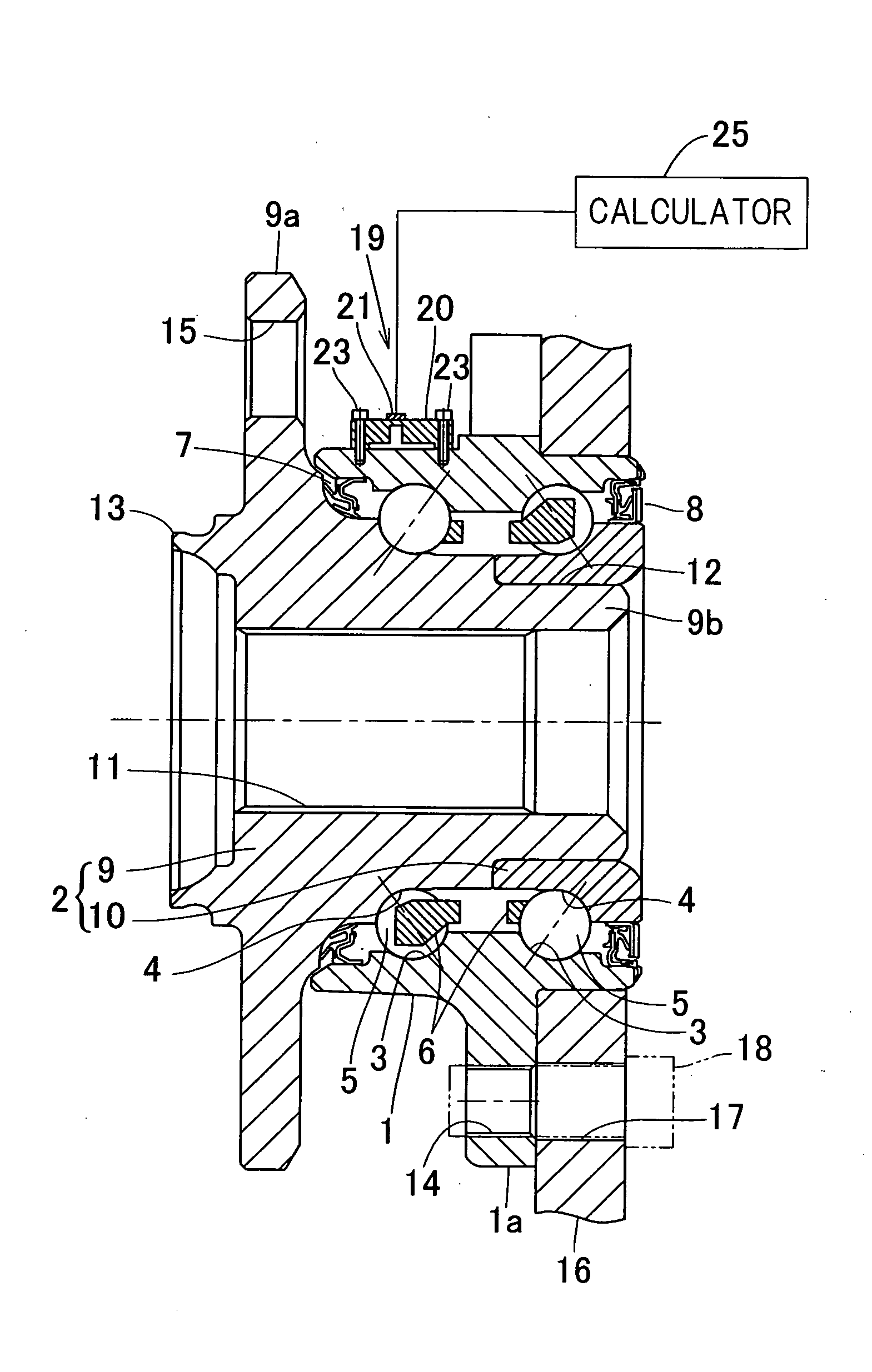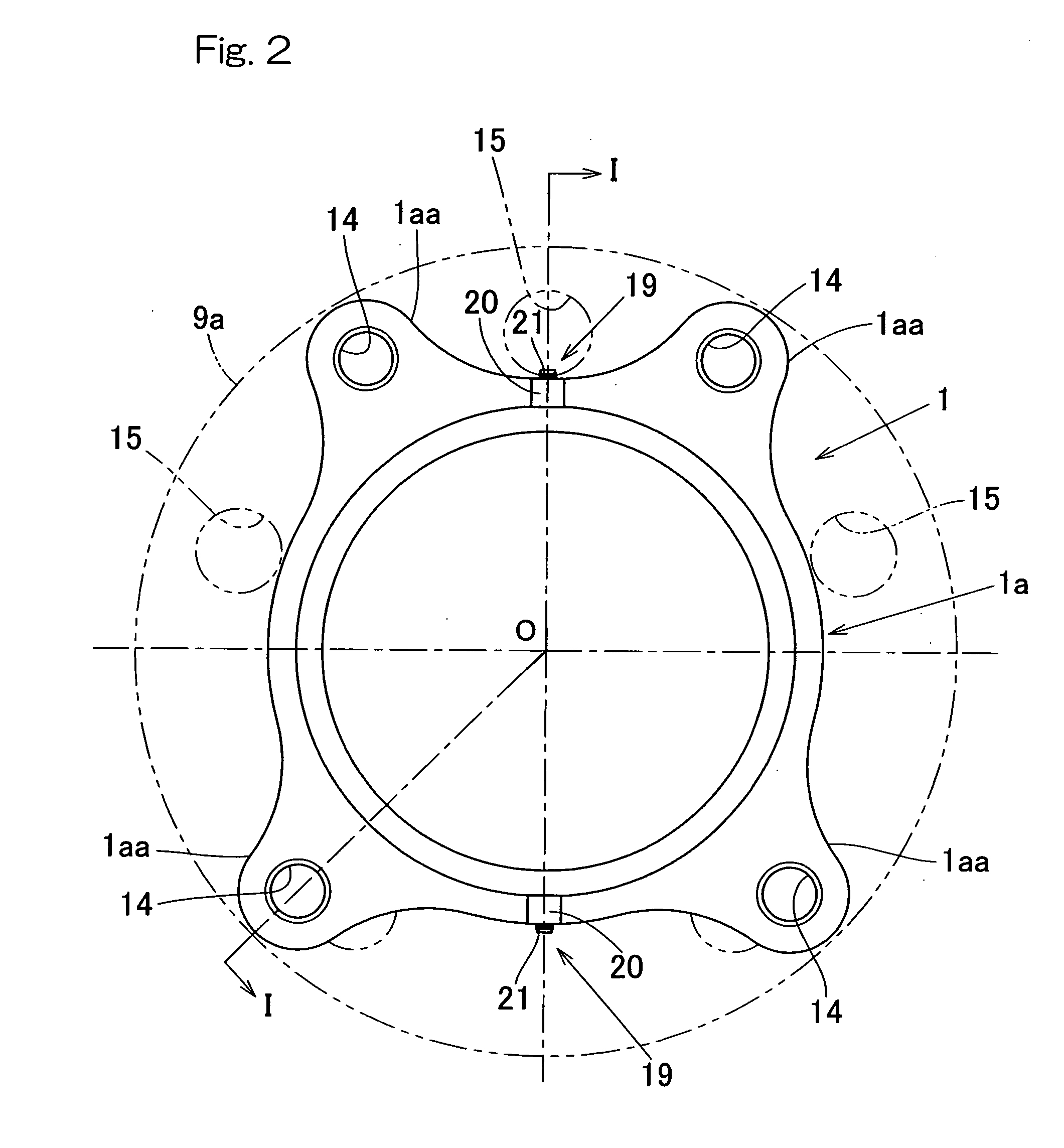Sensor-equipped bearing for wheel
a technology for supporting bearings and wheels, which is applied in the direction of apparatus for force/torque/work measurement, instruments, transportation and packaging, etc., can solve the problems of insufficient detection sensitivity, small strain, and hysteresis in output signals, so as to facilitate processing of sensor units and installation of sensors. , the effect of easy installation
- Summary
- Abstract
- Description
- Claims
- Application Information
AI Technical Summary
Benefits of technology
Problems solved by technology
Method used
Image
Examples
first embodiment
[0064]the present invention will now be described in detail with particular reference to FIGS. 1 to 3. This embodiment is directed to a inner ring rotating type wheel support bearing assembly of a third generation model, which is used to rotatably support a vehicle drive wheel. It is to be noted that in the description that follows, one side of a vehicle body structure laterally away from the longitudinal center thereof in a condition, in which the bearing assembly is mounted on the vehicle body structure, is referred to as “outboard side” while the opposite side of the vehicle body structure laterally close towards the longitudinal center thereof in the same condition is referred to as “inboard side”.
[0065]A bearing unit employed in this sensor-equipped wheel support bearing assembly includes, as shown in a sectional view in FIG. 1, an outer member 1 having an inner periphery formed with a plurality of rolling surfaces 3, an inner member 2 having rolling surfaces 4 defined therein ...
second embodiment
[0090]Other structural features are similar to those shown in and described with reference to FIGS. 5 to 7 in connection with the previously described It is to be noted that the counterbore 22a may only be provided in the bolt insertion hole 22 with the chamfered corner portion 26 dispensed with. The formation of the counterbore 22a in the bolt insertion hole 22 allows the head 23a of the bolt 23 to be buried within the surface portion 20aa of the contact fixing segment 20a and, therefore, any possible interference of the bolt head 23a with the hub bolts 13 can be avoided advantageously. Also, mere formation of the counterbore 22a in the bolt insertion hole 22 is so sufficient that the shape effective to avoid the interference with the hub bolts can be obtained with a simple processing.
[0091]Hereinafter, a fifth embodiment of the present invention will be described in detail with particular reference to FIGS. 10 to 13A and 13B. In those figures, component parts similar to those sho...
fifth embodiment
[0092]In this fifth embodiment of the present invention, the cutout portion 20c is formed in the strain generating member 20 of the sensor unit 19 at a location on the outboard side and remote from the middle portion between the two contact fixing segments 20a and 20b. As shown in FIGS. 12A and 12B showing one example of the structure of the sensor unit 19 in a front elevational view and a bottom plan view (a representation as viewed from the inner surface side confronting the outer diametric surface of the outer member 1), respectively, the illustrated instance utilizes the cutout portion 20c of such a shape that a portion of the outer surface of the strain generating member 20 is cut out inwardly of the strain generating member 20 towards an inner surface thereof. This cutout portion 20c has a widthwise dimension that is rendered to be 2 mm or smaller. The sensor 21 is pasted to an area of the strain generating member 20, where the strain occurs considerably relative to a load act...
PUM
 Login to View More
Login to View More Abstract
Description
Claims
Application Information
 Login to View More
Login to View More - R&D
- Intellectual Property
- Life Sciences
- Materials
- Tech Scout
- Unparalleled Data Quality
- Higher Quality Content
- 60% Fewer Hallucinations
Browse by: Latest US Patents, China's latest patents, Technical Efficacy Thesaurus, Application Domain, Technology Topic, Popular Technical Reports.
© 2025 PatSnap. All rights reserved.Legal|Privacy policy|Modern Slavery Act Transparency Statement|Sitemap|About US| Contact US: help@patsnap.com



